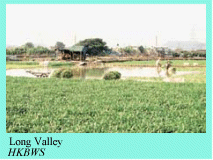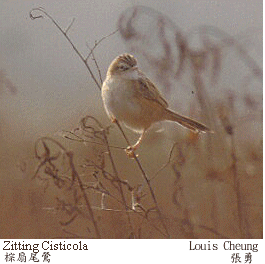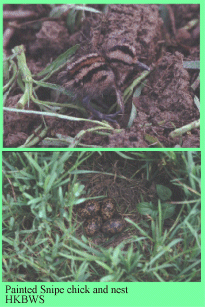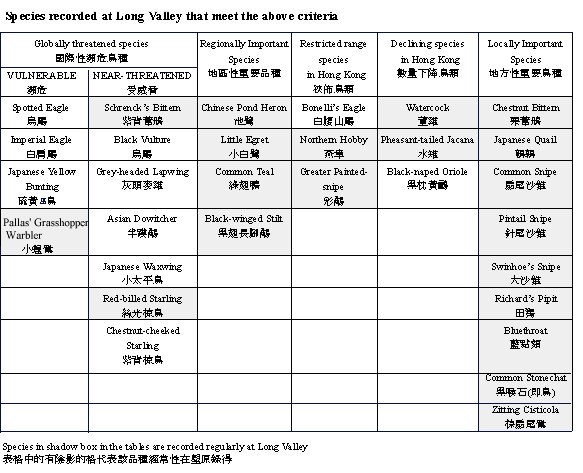
The Importance of Long Valley
 Habitat Habitat
 Bird species Bird species
Long Valley is widely acknowledged to be of importance to birds, it is noteworthy that over 210 species have been recorded from Long Valley since 1993 (almost 50% of the species recorded in Hong Kong).
Why Long Valley is an important site?
- Due to its hydrology and water supply, it functions as a freshwater wetland
- It has minimal habitat fragmentation
- It has low levels of human disturbance
- It has a high degree of mirco-habitat diversity
Freshwater wetland
 This combination of features combines to make Long Valley almost unique in Hong Kong. The only similar wetland would be Kam Tin, which is facing even greater levels of development. While there are protected freshwater wetlands in Hong Kong, none that are important for birds are protected. Many similar areas have been lost to or substantially damaged by development (Ha Tsuen, Fairview Park, Lok Ma Chau, and Yuen Long marshes). This combination of features combines to make Long Valley almost unique in Hong Kong. The only similar wetland would be Kam Tin, which is facing even greater levels of development. While there are protected freshwater wetlands in Hong Kong, none that are important for birds are protected. Many similar areas have been lost to or substantially damaged by development (Ha Tsuen, Fairview Park, Lok Ma Chau, and Yuen Long marshes).
Fragmentation
Fragmentation is a key issue here. From the ecological point of view, the smaller the area of habitat, the lower the number of species can be found. In Hong Kong, there are no small wetlands that support avian communities of any ecological value. For example, Lok Ma Chau has suffered serious fragmentation because of the drainage works there; as such, it is now very poor for freshwater wetland species. For example, the gallinago snipe are far less common there now, and although it once bred there, Greater Painted-snipe no longer occurs there.
Human disturbance
 For Hong Kong, Long Valley is a relatively undisturbed area. Many of the species that are found in Long Valley and Kam Tin are easily disturbed, for example, Grey-headed Lapwing. Such species require large, open areas with low levels of disturbance; Long Valley is really the only remaining site that satisfies these criteria. For Hong Kong, Long Valley is a relatively undisturbed area. Many of the species that are found in Long Valley and Kam Tin are easily disturbed, for example, Grey-headed Lapwing. Such species require large, open areas with low levels of disturbance; Long Valley is really the only remaining site that satisfies these criteria.
Micro-habitats
The mix of micro-habitats at Long valley, while unplanned, helps support a whole suite of wetland specialists, from Greater Painted-snipe to Bluethroat. It is also important to understand that many of these are either absent, or present in much lower densities within the Ramsar site, as that area is either the wrong, or sub-optimal habitat for these species.
Besides Deep Bay area, Long Valley is another place in Hong Kong where we can find globally threaterned species, The criteria used to define important species are:
1. Globally threatened species.
 Birds to Watch 2 (Collar et al. 1994) is published by BirdLife International, and lists all of the threatened bird species in the world. Species are allocated a category according to the degree of the threat to each taxon. Classes relevant to Hong Kong are: Birds to Watch 2 (Collar et al. 1994) is published by BirdLife International, and lists all of the threatened bird species in the world. Species are allocated a category according to the degree of the threat to each taxon. Classes relevant to Hong Kong are:
- Critical: extremely high risk of extinction in the wild in the near future
- Endangered: facing a very high risk of extinction in the wild in the near future.
- Vulnerable: facing a high risk of extinction in the wild in the medium-term future
- Near threatened: those taxa close to qualifying for the threatened categories.
2. Regionally Important Species
Rose and Scott (1997) give population estimates for waterfowl world-wide, and set the 1% world or migration route population levels for identifying wetlands of international importance under the Ramsar Convention criteria. Using this 1% threshold, Carey and Young (1999) identified 41 species occurring within the Mai Po Marshes and Inner Deep Bay Ramsar Site which can be considered to certainly or possibly to fit the Ramsar criteria. Of these a number are regularly recorded at Long Valley in such numbers that it is considered that the loss of Long Valley will result in significant adverse impacts on the Hong Kong population of these species.
3. Restricted range species in Hong Kong
 Species (including non-breeding species) which are found or breed at fewer than three sites in Hong Kong. Species (including non-breeding species) which are found or breed at fewer than three sites in Hong Kong.
4. Declining species in Hong Kong
Species (including non-breeding and locally extinct species) for which there is certain or probable long-term decline in Hong Kong.
5. Locally important species
Species which do not fit in the above categories, but for which locally important populations are regularly found within the Long Valley area. These are identified as species for which the highest annual count was within the study area, in at least three years for either of the two five-year periods (1988-92 and 1993-7). These species include some that are reason able widespread in Hong Kong, however, due to their abundance there, Long Valley is considered an important site for sustaining the long-term biodiversity of Hong Kong.

Copyright 1999, Hong Kong Bird Watching Society.
For comments and questions, please e-mail to hkbws@hkbws.org.hk.
|


 This combination of features combines to make Long Valley almost unique in Hong Kong. The only similar wetland would be Kam Tin, which is facing even greater levels of development. While there are protected freshwater wetlands in Hong Kong, none that are important for birds are protected. Many similar areas have been lost to or substantially damaged by development (Ha Tsuen, Fairview Park, Lok Ma Chau, and Yuen Long marshes).
This combination of features combines to make Long Valley almost unique in Hong Kong. The only similar wetland would be Kam Tin, which is facing even greater levels of development. While there are protected freshwater wetlands in Hong Kong, none that are important for birds are protected. Many similar areas have been lost to or substantially damaged by development (Ha Tsuen, Fairview Park, Lok Ma Chau, and Yuen Long marshes). For Hong Kong, Long Valley is a relatively undisturbed area. Many of the species that are found in Long Valley and Kam Tin are easily disturbed, for example, Grey-headed Lapwing. Such species require large, open areas with low levels of disturbance; Long Valley is really the only remaining site that satisfies these criteria.
For Hong Kong, Long Valley is a relatively undisturbed area. Many of the species that are found in Long Valley and Kam Tin are easily disturbed, for example, Grey-headed Lapwing. Such species require large, open areas with low levels of disturbance; Long Valley is really the only remaining site that satisfies these criteria. Birds to Watch 2 (Collar et al. 1994) is published by
Birds to Watch 2 (Collar et al. 1994) is published by  Species (including non-breeding species) which are found or breed at fewer than three sites in Hong Kong.
Species (including non-breeding species) which are found or breed at fewer than three sites in Hong Kong.